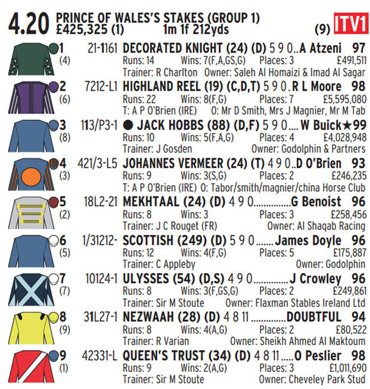Heading to the races for your first time is an exciting prospect but you might be concerned about what everything means because it can all seem rather daunting. However, don’t let that put you off because we are going to help you understand race cards in order to help you get the most from your experience.
Here is an example race card that we will look at, we will go from the left so you can understand what this all means –

Jockey Colours
You’ll notice that the jockeys are wearing certain colours and these will help you to identify them when they are racing. The colour is a reflection of who the owner is – they all have their own colours.
Race Number and Draw
Alongside each horse, you will see a number and they are numbered in numerical order such as 1 to 9. In some instances, especially with online racecards, the horses might be listed in order of the favourite. However, underneath the number, you will see a number in brackets and this is the number of the stall that the horse will race from in a flat race and is also known as its draw. This is the number that will be on the side of the horse. At major events, you may see this number on the large screens showing how the race is going.
Form – The Meaning of the Numbers
Now you will see some numbers and these relate to the form of the horse and an example would be 21-1161 in the above image. This is known as reading horse racing form.
- 21 – This indicates where the horse finished in the races that they raced last year and their most recent race is always to the right, so, in the case of Decorated Knight, they won the last race and so, the numbers indicated where they finished. If you see a 0, it means they did not finish.
- A dash – if there is a dash, this is split between seasons. The numbers before the dash are for the previous season.
- 111 – This relates to the finishing position of the horse in their races this year, with the latest races being on the right.
- If you look down the list, you will see a slash (/) next to Jack Hobbs and this can mean that the horse missed a long period.
- There are other letters that you will need to consider and these include:
- P or PU – The jockey pulled the horse up which means it did not finish the race
- F – The horse fell
- R – Horse refused to race
- BD – Another runner brought the horse down
- U or UR – The horse unseated its jockey
The Name of the Horse
The next info is the name of the horse and the number following this in brackets is the number of days since the horse last raced. You might then notice some abbreviations such as:
- C – The horse has won a race at this course previously
- D – Horse has been successfully running this distance before
- CD – Horse has won at this course and this distance previously
- BF – the horse was a favourite for its previous race but did not win
The Age and Weight of the Horse
Now you will see another set of numbers and these relate to the age and weight of the horse. In the case of Decorate Knight, you will see that is 5 years old and it weighs 9 Stone 0lbs
The Jockey
Next is the name of the jockey and while you might want to find a horse that is performing well, it is also useful to recognise the success of the jockey or stable.
Horse Racing
On certain racecards, you might also see the horse rating which is the official BHA rating. Horses are given ratings once they have raced a certain number of races, giving the handicappers the ability to give the horse a numerical assessment.
Runs, Wins, Places and Prize Money
This is not information that you will find on all race cards but it is fairly easy to understand.
Trainer and Owner
Again, this is easy to understand but it will enable you to determine whether the trainers are in form and whether they have a good record at a certain course.
So, now you have a clear understanding of what racecards mean, the next time you head to the races, you’ll be able to understand where to place your bets.
Now you are loaded up with all the info you can confidently say you can understand racecards. If you’re at the racecourse and fancy placing a bet try the on-course bookmakers to see the odds on all the day’s races.



